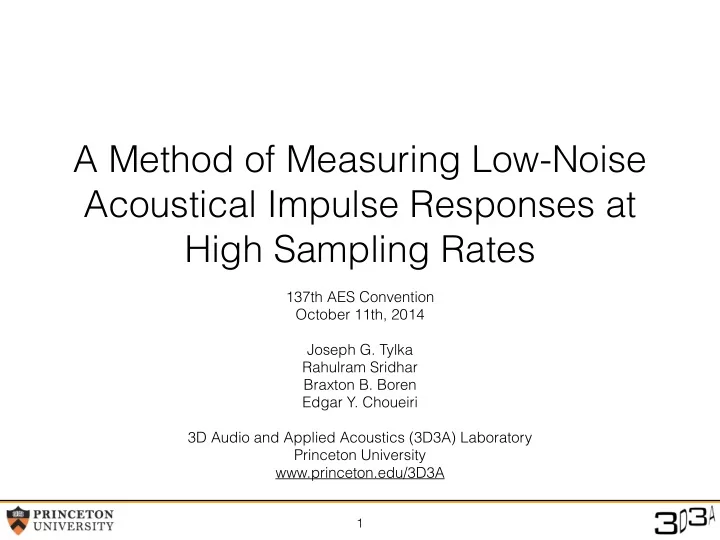

A Method of Measuring Low-Noise Acoustical Impulse Responses at High Sampling Rates 137th AES Convention October 11th, 2014 ! Joseph G. Tylka Rahulram Sridhar Braxton B. Boren Edgar Y. Choueiri ! 3D Audio and Applied Acoustics (3D3A) Laboratory Princeton University www.princeton.edu/3D3A 1
Applications HRTF Measurements 3D3A Lab, Princeton University 2
Objectives • Measurements at high sampling rates (>48 kHz) • Efficient, low-noise, and artifact-free measurements 3
Approach Initial Measurement Refined Measurement Processing 4
Outline • Review: impulse response (IR) measurements • Measurements at high sampling rates • Proposed measurement procedure • Experimental results 5
IR Measurements + x(t) y(t) h(t) w(t) n(t) • Exponential sine sweep (ESS) [1, 2] • Deconvolution [1] A. Farina (2007) Advancements in Impulse Response Measurements by Sine Sweeps [2] S. Müller and P. Massarani (2001) Transfer-Function Measurements with Sweeps 6
Exact Deconvolution Input spectrum Exact inverse + Magnitude (dB) Magnitude (dB) -3 dB/oct +3 dB/oct Signal Noise Frequency (Hz) Frequency (Hz) Noise Magnitude (dB) = Signal Frequency (Hz) 7
Time-Reversed Deconvolution Input spectrum Time-reversed inverse [1] + Magnitude (dB) Magnitude (dB) -3 dB/oct +3 dB/oct Signal Noise Frequency (Hz) Frequency (Hz) Magnitude (dB) = Signal Noise Frequency (Hz) 8
Exact deconvolution Time-reversed deconvolution Noisy Pre-response (16%) SNR = 25 dB SNR = 32 dB An improvement of 7 dB due to BPF Settings: 96 kHz sampling rate, 5 second sweep from 20 Hz to 24 kHz 9
Why high sampling rates? • Ultrasonic transducers • “Time-smear” [3] • Minimum interaural time difference ~ 10 μ s [4] • Facilitate subjective tests [3] P. G. Craven (2004) Antialias Filters and System Transient Response at High Sample Rates [4] A. W. Mills (1958) On the Minimum Audible Angle 10
Challenges • Signal-to-noise ratio (SNR) • Deconvolution issues • Transducer heating/damage 11
Measurement Procedure Initial Measurement Determine Pass-Band Refined Measurement Band-Pass Filter 12
Defining the Pass-Band • Improved signal-to-noise ratio • Minimal filtering artifacts (PDA) • User preferences • Cost function? 13
Optimal SNR Signal and Noise Magnitude (dB) Signal Noise Frequency (Hz) Pass-Band 14
Optimal SNR Signal and Noise Magnitude (dB) Signal Noise + 2.1 dB Frequency (Hz) Pass-Band 14
Example Implementation START Phase II Phase I Determine optimal-SNR Design and execute phase- pass-band and estimate controlled ESS [5] corresponding PDA Phase II Input preference: keep/reject PDA no Is preference to reject PDA? yes Input max. PDA Phase III Design and execute refined Determine constrained-PDA ESS with fade-out pass-band II Band-pass filter mic. signal Deconvolve mic. signal by input sweep to get IR [5] K. Vetter and S. di Rosario (2011) ExpoChirpToolbox: STOP a Pure Data implementation of ESS impulse response measurement 15
Optimal SNR 16
Results Note: all measurements were performed with an output level of 75 dB SPL (1 kHz, 1 m) Sweep Frequency Range Raw SNR BPF SNR Pre-response Length (s) (dB) (dB) Peak (%) Initial ~1 23 Hz — 48 kHz 21 — — Measurement Optimal SNR 5 26 Hz — 40.6 kHz 24 37 <0.2 Conventional 5 20 Hz — 24 kHz 25 32 16 ESS Exact deconv. Time-reversed deconv. 17
Summary • IR measurements at high sampling rates (>48 kHz) • Customizable measurement procedure • SNR improvement with minimal filtering artifacts 18
Acknowledgements This work was conducted under a contract from the Sony Corporation of America. 19
Thank You josephgt@princeton.edu 20
References 1. A. Farina, “Advancements in Impulse Response Measurements by Sine Sweeps,” presented at the AES 122nd Convention, May 2007. 2. S. Müller and P. Massarani, “Transfer-Function Measurements with Sweeps,” J. Audio Eng. Soc., 49(6):443-471, 2001. 3. P. G. Craven, “Antialias Filters and System Transient Response at High Sample Rates,” J. Audio Eng. Soc., 52(3):216-242, 2004. 4. A. W. Mills, “On the Minimum Audible Angle,” J. Acoust. Soc. Am., 30(4):237-246, 1958. 5. K. Vetter and S. di Rosario, “ExpoChirpToolbox: a Pure Data implementation of ESS impulse response measurement,” presented at the 4th Pure Data Convention, 2011. 21
Recommend
More recommend